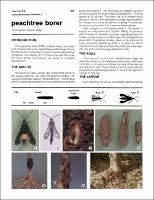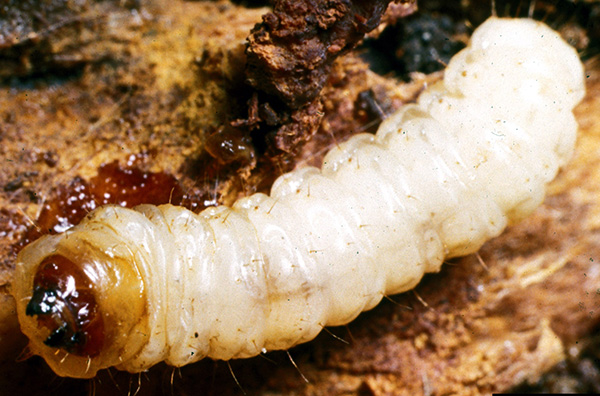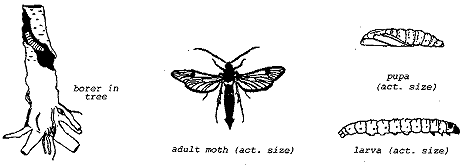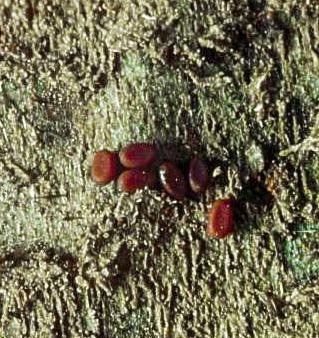peach tree borer life cycle
The newly hatched larvae bore into the inner bark forming tunnels and filling them with frass. During this time eggs are laid on.
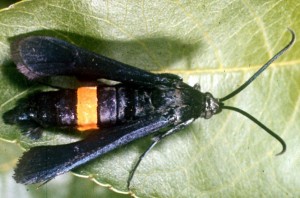
Peachtree Borer Oklahoma State University
Damage Any wound on stone fruit trees may cause gum to exude.
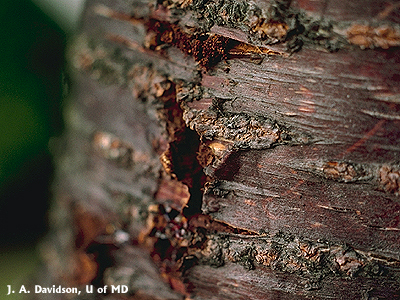
. Unlike most moths LPTB are active during the day usually between mid-morning and mid-afternoon. Larvae tunnel primarily into the lower trunk and roots feeding on growing tissue and inner bark. Life Cycle The period of time required to complete a life cycle varies considerably throughout the range of the peachtree borer.
Mating disruption may be used in orchards than 1 acre. If a plant is healthy the larvae may be killed by sap flow. Lesser peach tree borers have a life cycle very similar to that of peach tree borer but the timing and location of attack are slightly different.
When mature the larva constructs a cocoon under the bark at or near soil level and pupates. The life cycle of the peachtree borer requires one year to complete. The period of time required to complete a life cycle varies considerably throughout the range of the peachtree borer.
Monitor using delta traps and greater peachtree borer pheromone lure starting in mid-June. Life cycles of peachtree borers and lesser peachtree borers. It is reported that it takes two years to complete a life cycle in Canada and in a small percentage of populations in New York.
After mating in mid- to late summer the female peach tree borer lays her red eggs on the bark of. The borer will remain in the pupal stage from 18 to 30 days before emerging as an adult. Life Cycle and Damage.
Egg laying begins soon after emergence and mating and larvae tunnel into the bark to feed until the. The adults are clear-winged day-flying moths which are often mistaken. Upon hatching from the eggs Figure 4.
Usually they are close to or below ground level. This borer can girdle and kill a. Adult moths of the lesser peachtree borer emerge from late May through September while peachtree borers emerge from midJune to early September.
Peach tree borer injury is less common here on plums and cherries but might occur. The borer has a two-year life cycle. Avoid winter trunk injury by painting the lower 12 inches of trunk with a 5050 latex paintwater solution.
The adult female lays eggs in bark crevices. Because the egg laying period is so long overwintering larvae vary greatly in size. The peachtree borer overwinters as a partly grown larva in its burrow beneath the bark of the tree.
Its the creamy-white larvae that create havoc in your backyard orchard. This is in contrast to lesser peachtree borer which may feed on any part of the tree Root feeding leads to reduced crop bearing capacity due to lack of nutrient uptake while heavy trunk feeding can. The winter is spent as a larva under the bark.
Upon hatching the larvae bore just beneath the bark near the ground level and into the roots to feed on growing tissue and inner bark. They also attack Plums and Cherry trees in the residential landscape and can weaken and eventually kill these trees by girdling the trunks under the bark. Peach tree borers overwinter as partially grown larvae in a gallery under the bark.
The presence of small particles of wood and bark within the gum distinguish damage by peachtree borer Life History and Habits The life cycle of the peachtree borer requires one year to complete. The adult peachtree borer is a steel blue to black moth that resembles a wasp. Much of the United States including Texas and Nebraska has one generation per year.
Adults which resemble wasps are most prevalent from mid-May to early October. Hang monitors as close to the ground as possible. Adult beetles usually appear in May and June with egg-laying continuing until late July.
Peach tree borers attack near the soil line with most activity occurring a few inches 5 to 75 cm below the ground. Produced by peachtree borer. Eggs typically are inserted into the bark of the trunk near the ground although eggs may occasionally be laid in tree crotches.
Only the immature larva stage Figure 3 produces the damage to trees. Borer damage is usually attended by gumming with varying amounts of frass in the gum. The peach tree borer completes one life cycle a year.
Lesser peach tree borers attack higher on the trunk and scaffold branches. Peach Tree Borers feed under the bark of Peach trees and are a serious pest in commercial peach orchards. Use resistant tree varieties.
When full grown the larva is 1-14 in long cream colored with a dark brown head. Hatching larvae tunnel into the tree at or slightly below ground level. In the spring larvae feed briefly pupate and emerge as adults 3 to 4 weeks later.
In the spring the larva will construct a silken cocoon and cover it with tiny bits of chewed wood. Upon hatching from the eggs young larvae. Winter is spent as a larva under the bark in the cambium layer.
The lesser borer completes about one and one-half cycles a year. Eventually the bark begins to peel off damaged areas making the tree susceptible to other pests and disease. The Peachtree Borer By Elaine Pugh Fairfax Master Gardener male peachtree borer The peachtree borer infects and overwinters in trees from the Prunus genus including cherry apricot nectarine plum prune and peach varieties.
Peach tree borers attack near the soil line with most activity occurring a few inches 5 to 75 cm below the ground. In the spring feeding is resumed and the larval period is completed. Adult beetles are dark metallic brown to dull gray about 12 inch long.
It is reported that it takes two years to complete a life cycle in Canada and in a small percentage of populations in New York. Female Peachtree Borers lay their eggs on the tree trunks or at the base of the tree and lay 500-600 eggs on average. Adults begin mating shortly after emergence and females deposit eggs in large masses in the crevices of bark.
Life Cycle Appearance. The clear-winged female moths lay their eggs on the bark at the base of tree trunks in mid- to late-summer. The adult borer emerges in the late spring and early summer.
The larval stage of PTB is an indirect pest of stone fruit trees.

Peach Tree Borer Treatment Control Planet Natural

Peach Tree Borer Fairfax Gardening
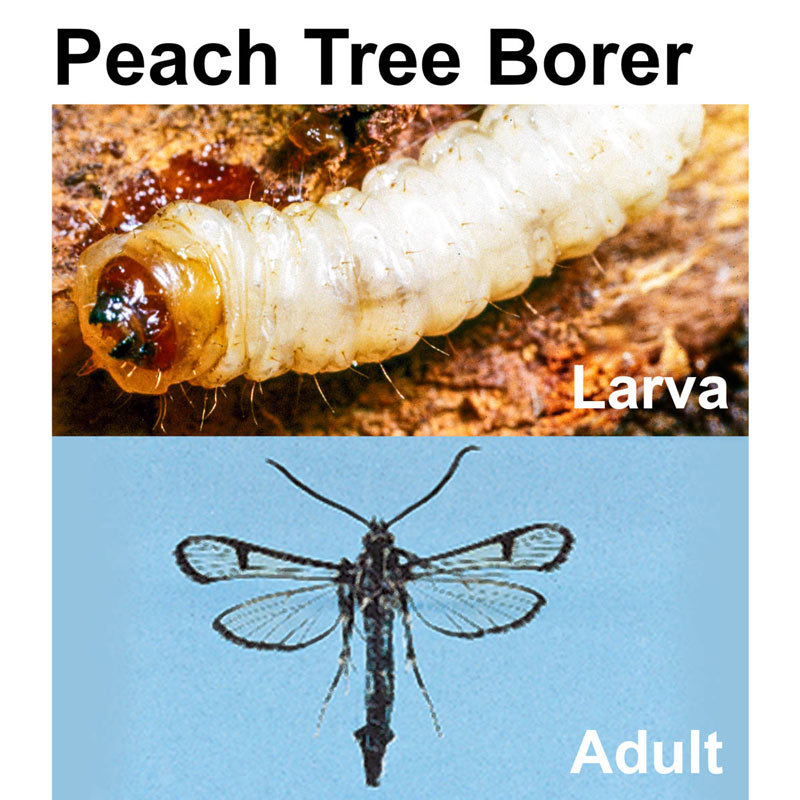
Peach Tree Borer Trap Pest Control From Gardens Alive
Peachtree Borer Wsu Tree Fruit Washington State University

Goes To Show You Don T Ever Know Plant Pest Advisory
Pests Bc Tree Fruit Production Guide
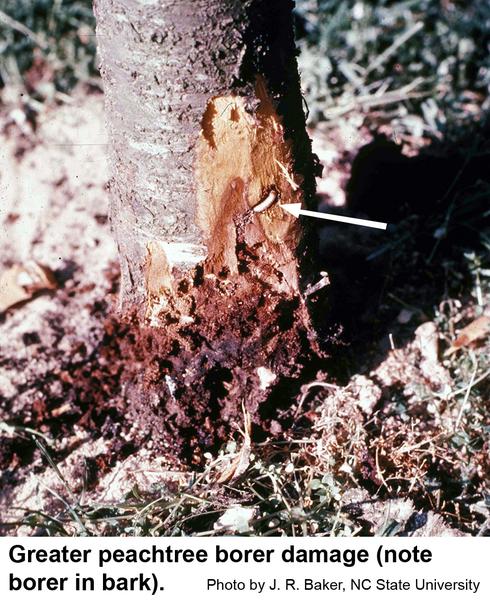
Greater Peachtree Borer In The Landscape Nc State Extension Publications
Pests Bc Tree Fruit Production Guide
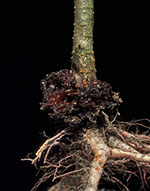
Peachtree Borer 5 566 Extension
Eny 691 In489 Peachtree Borers In The Home And Commercial Peach Orchard

Peach Tree Borers How To Control Peach Tree Borers
Pests Bc Tree Fruit Production Guide

Lesser Peachtree Borer Nc State Extension Publications
